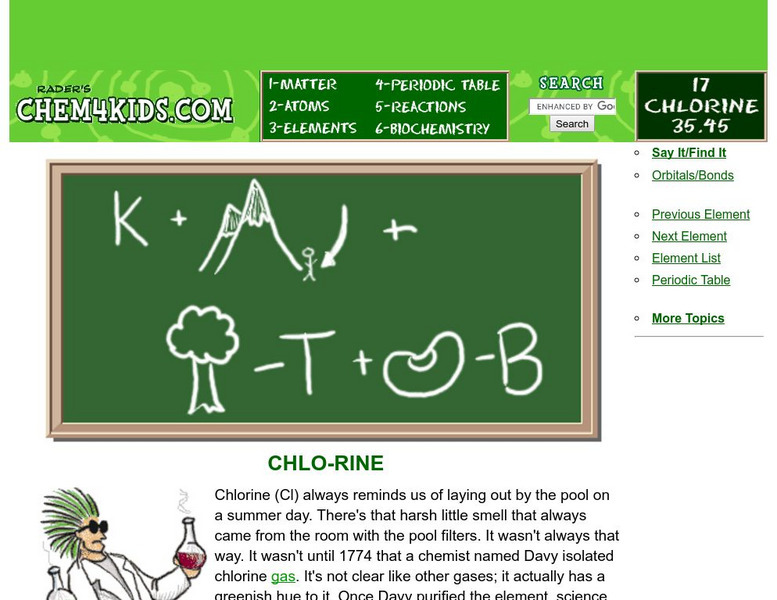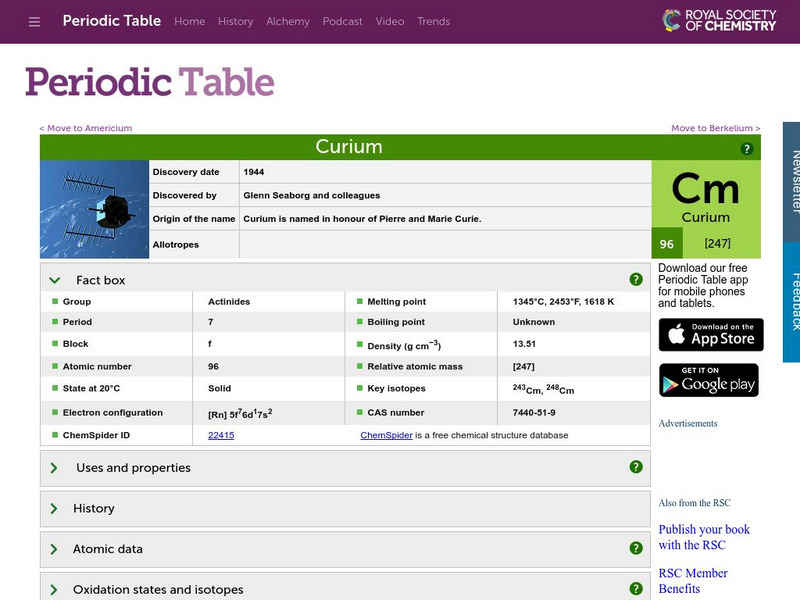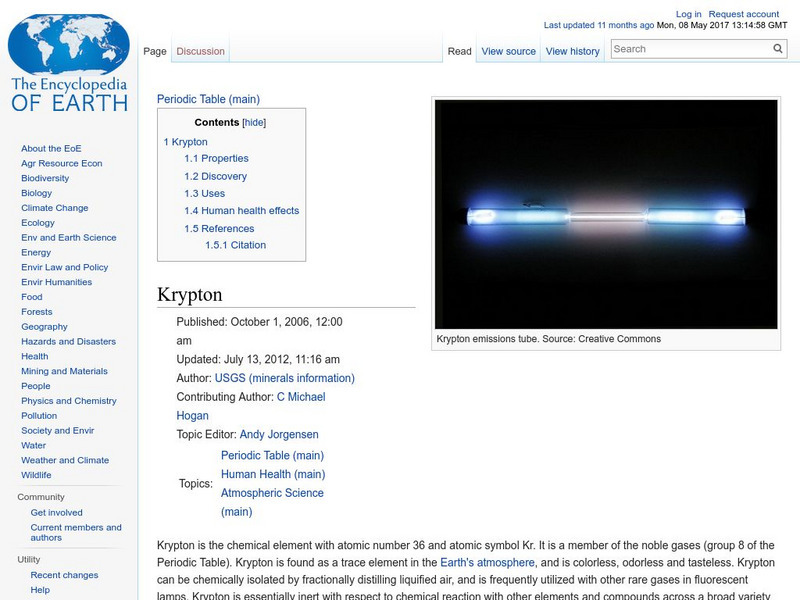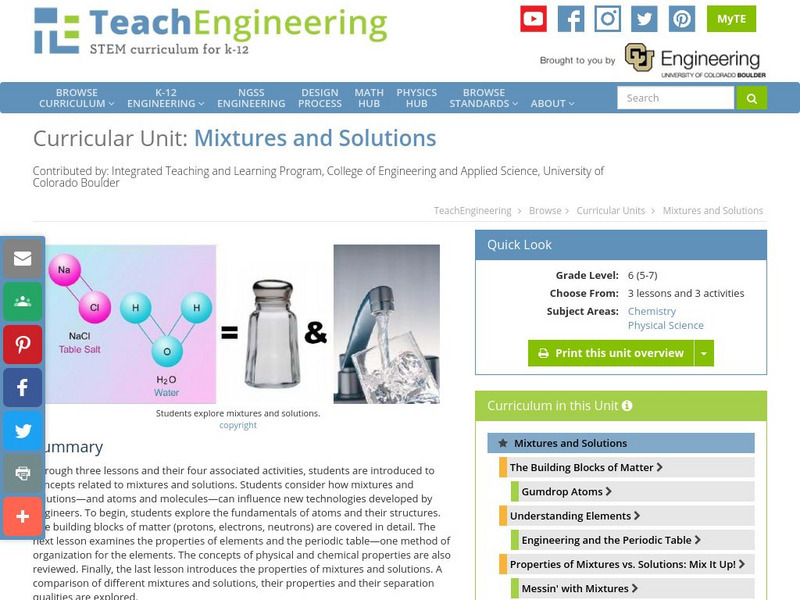Hi, what do you want to do?
Chem4kids
Chem4 Kids: Phosphorus (P)
Here you can find some great information about the 15th element in the periodic table, "phosphorus." Content focuses on phosphorus' electrons, where you can find phosphorus in nature and in the home, and how phosphorus combines with...
Chem4kids
Chem4 Kids: Argon (Ar)
Chem4Kids looks at the 18th element in the periodic table, argon. Content focuses on argon's electrons, where you can find argon in nature and in the home, and how argon combines with other elements.
Chem4kids
Chem4 Kids: Chlorine (Cl)
The 17th element in the periodic table is defined, chlorine. Find out how many electrons chlorine has and where you can find it in nature and in the home.
Environmental Chemistry
Environmental chemistry.com: Periodic Table Phosphorus
Excellent source of information on phosphorus including its physical and chemical properties. Highly recommended.
Ducksters
Ducksters: Kids Science: Elements
Kid's learn about the science of chemical elements. Basic forms of matter made from a single type of atom.
Sophia Learning
Sophia: Characteristics of Elements: Lesson 3
This lesson will present the basic properties and characteristics of elements. It is 3 of 4 in the series titled "Characteristics of Elements."
Sophia Learning
Sophia: Characteristics of Elements: Lesson 2
This lesson will present the basic properties and characteristics of elements. It is 2 of 4 in the series titled "Characteristics of Elements."
Annenberg Foundation
Annenberg Learner: What's in the Box?
Use your knowledge of groups and periods on the Periodic Table. When you are presented with three elements, pick the one that doesn't belong.
Upper Canada District School Board
Tom Stretton's Chemistry Pages: Evolution of the Elements
Through an online slide-show format, learn about the historical development of the Periodic Table of Elements.
Chemicool
Chemicool: Bromine
A nicely organized summary table with information on the properties of bromine. Very helpful and easy to follow.
Encyclopedia of Earth
Encyclopedia of Earth: Periodic Table: Krypton
Information about the element, Krypton, atomic number 36. Covers physical and atomic properties, how abundant it is on the Earth, how it was discovered, uses, and health effects from exposure.
Texas Education Agency
Texas Gateway: Atoms, Elements and the Periodic Table: The Atomic Model [Pdf]
A slideshow looking at the contributions of scientists over time to our understanding of atomic theory. Looks at models of the atom developed by Democritus, John Dalton, J.J. Thomson, Ernest Rutherford, Niels Bohr, and James Chadwick, as...
Sophia Learning
Sophia: Identifying Valence Electrons
A slide show presentation which demonstrates how to identify the number of valence electrons an element has based on its location on the periodic table.
Khan Academy
Khan Academy: Quiz: Stars and Elements
A quiz over stars and elements. Students can test their understanding of the star and element unit that covered over chemistry, periodic table of elements, and famous scientists. Quiz contains thirteen multiple choice questions.
Society for Science and the Public
Science News for Students: Heaviest Named Element Is Official
Describes the discovery and naming of copernicum, the heaviest element on the Periodic Table, named after the 16th century scientist Nicolaus Copernicus.
Web Elements
Web Elements Periodic Table: Atomic Radius
This Webelements website provides a short but detailed definition of atomic radius. Includes links to other chemistry sites.
Curated OER
[Periodic Table of the Elements]
The periodic table arranges elements according to their properties. This page allows you to click on the element as it appears on the table and obtain information on its structure, behavior, and discovery.
Chemicool
Chemicool: Radon
This site provides a set of data tables summarizing the physical and chemical properties and data on radon.
World Food Programme
Free Rice: Chemical Symbols (Full List)
Play this game and help to end world hunger! For every correct answer, ten grains of rice will be donated to the UN World Food Programme. Try this question set covering all the chemical elements of the Periodic Table. The level of the...
World Food Programme
Free Rice: Chemical Symbols (Basic)
Play this game and help to end world hunger! For every correct answer, ten grains of rice will be donated to the UN World Food Programme. Try this question set covering the basic chemical elements of the Periodic Table. The level of the...
TeachEngineering
Teach Engineering: Mixtures and Solutions
This unit covers introductory concepts of mixtures and solutions. Students think about how mixtures and solutions, and atoms and molecules can influence new technologies developed by engineers. The first lesson explores the fundamentals...
BBC
Bbc: Gcse Bitesize Science: Atomic Structure
An explanation of atomic structure and the element groups in the periodic table using plain language. Supported by diagrams and charts.
Concord Consortium
Concord Consortium: Stem Resources: Atomic Structure
Introduces learners to atomic models of the past and present, focusing on the orbital model and an explanation of its basis. Learners then have the opportunity to "make an atom" and contrast it with an ion, followed by an isotope. The...
Other popular searches
- Periodic Table of Elements
- Periodic Table of the Elements
- Periodic Table Elements
- Periodic Table and Elements
- Periodic Table Elements Unit























